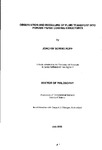OBSERVATION AND MODELLING OF FLUID TRANSPORT INTO POROUS PAPER COATING STRUCTURES
| dc.contributor.author | SCHOELKOPF, JOACHIM | |
| dc.contributor.other | Faculty of Science and Engineering | en_US |
| dc.date.accessioned | 2013-10-29T12:54:28Z | |
| dc.date.available | 2013-10-29T12:54:28Z | |
| dc.date.issued | 2002 | |
| dc.identifier | NOT AVAILABLE | en_US |
| dc.identifier.uri | http://hdl.handle.net/10026.1/2445 | |
| dc.description | Merged with duplicate record 10026.1/581 on 14.03.2017 by CS (TIS) | |
| dc.description.abstract |
In paper printing, one of the most important aspects for consideration is the control of ink setting rate. Ink setting, depending on ink and press type, is a function of evaporation, curing and removal of the liquid phase by capillary mechanisms steered by the porous substrate. In most cases, absorption by the substrate is the dominating mechanism. Many paper or board substrates are coated with a layer of pigment panicles and binders. It is recognised that the void network between these panicles has the most important influence on the absorption dynamics. Many aspects of liquid absorption into porous networks are poorly understood. It is shown that it is necessary to characterise both the pore-level structure and the permeability of the network simultaneously. To remove indeterminate effects caused by the usually uneven thin layers of coatings adopted in practice, a novel methodology was developed in this work comprising of a range of unique techniques such as the formation of porous tablet-like blocks of CaC03. By applying variable compression forces to a compact of line-ground mineral, a wide range of usable porosities were obtained whilst keeping the surface chemistry and skeletal-defined pore geometry constant. The samples were characterised using mercury porosimetry. The methodology included techniques to study interactions of the structures with industrially and environmentally relevant liquids. An Ink-Surface Interaction Tester (ISIT) was used to analyse ink setting behaviour as a dynamic measure of ink rheology and solids content. This device was modified to provide a measure of the time-dependent extensional strain that is applied to the ink layer in addition to the normally obtained ink tack force values. The importance of the inertial flow regime beyond that of pure viscous flow and its impact in an interconnected network structure, where liquid does not imbibe continuously in a steady laminar flow behaviour at the wetting front, are demonstrated. Mechanisms are proposed which account for the uneven wetting line and its action in leaving parts of the pore network unfilled. Along with other findings, deviations from Lucas-Washburn (LW) scaling are elucidated. These findings are discussed in the context of paper printing and give direction for developing beyond the current limits encountered using environmentally friendly minerals and ink constituents. | en_US |
| dc.description.sponsorship | Omya AG, Oftringen, Switzerland | en_US |
| dc.language.iso | en | en_US |
| dc.publisher | University of Plymouth | en_US |
| dc.title | OBSERVATION AND MODELLING OF FLUID TRANSPORT INTO POROUS PAPER COATING STRUCTURES | en_US |
| dc.type | Thesis | |
| plymouth.version | Full version | en_US |
| dc.identifier.doi | http://dx.doi.org/10.24382/4125 |
Files in this item
This item appears in the following Collection(s)
-
01 Research Theses Main Collection
Research Theses Main


